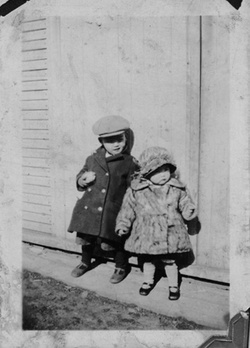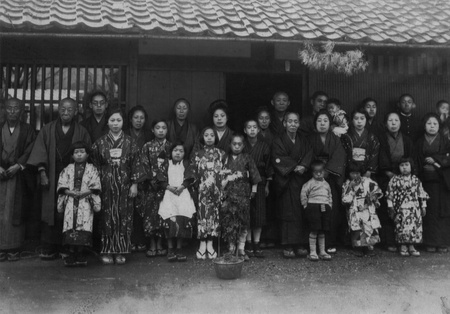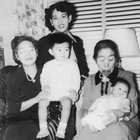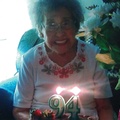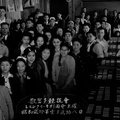The following are my siblings:
- Shigeru (Frank): b. 1924. He worked for the Dept. of Education, married Ruth Sasaki, divorced; Married Toshiko Otsuka, both deceased.
- Katsuyo (Kay): myself. b.1926. She married Ron Mende (deceased).
- Ayako (Betty): b.1930. She married Stony Nagata (deceased), lived in Richmond Hill
- Sachiko (Shirley): b. 1932 (deceased). She married Bob Takagi (deceased) and lived in Willowdale.
- Kinuko (Mary): b.1936. She lives in Toronto.
- Kenneth (Kenji): b.1940. He lives in House of Wellness, Brampton (care- assisted home).
Two infantile deaths:
- Masaru (first born – 1923): died 1925 - diphtheria
- Mitsue (b. 1927): died when she was about 100 days old after being bitten by a rat. Dad did not get to know her as she was born and died in his absence while he was working up north.
When we were forced out of our old house, we moved one block east into an empty store owned by a Chinese businessman, who operated the “Sun Peking Chop Suey House” on the second floor, above which was a rooming house run by a Japanese couple, the Kitamuras.
Mrs. Kitamura was one of the school teachers at the local Japanese Language School. I remember while we occupied the premises, once in a while, we phoned to call the restaurant upstairs and order a dish from their menu for dinner, a treat. Can you imagine one dish shared by eight?! It was a luxury in any case.
The new premises were in the midst of many Japanese establishments—pharmacies, shoe stores, men’s wear, fish markets, etc. Across from us was a Japanese restaurant owned and operated by a Mrs. Ujihara; her daughter, Haruye, became one of my good friends. There were stores unique to Japanese customers where tofu was made and live chickens were kept on the premises to be sold to customers. There were also numerous Japanese public bath-houses.
Dad had to convert the new place of business to a barber shop for Mom, equipped the front portion with a chair, accessories, and a hot-water tank system. The rear of the building was partitioned off to become our living areas. There were three bedrooms, one for Frank, one for Betty (who suffered many nights unable to sleep with her asthma) and myself, and a large third bedroom for the rest. There was a living/sitting room with a stove to warm up the entire house, a kitchen/dining room, and a small area for family laundry with a pulley contraption for hanging the wash. In the washroom, Mom put a large tub for the family to use for bathing. A door opened to the rear outside where Frank used to chop wood for the stove.
Even at this new location, Mom worked hard. Sometimes she closed the shop for a few hours, running down to the local department store, Woodward’s, to see whether she could find any bargains. I remember a butcher shop doing business across from Woodward’s where the prices of the meat products were reasonable (meaning, cheap) where she did a lot of her shopping. We used to love going down to Woodward’s basement food section where they had dishes of free cookies and biscuits out on the counters for the customers to sample. We helped ourselves to a few of them.
I never had any chance to go out looking for a job, but there was one time when I did make a few dollars. It was with a small family business. I think the family was related to the Sawadas of the barber shop. The son of the family went out early in the morning on his fishing boat to net small shrimps, cooked them onboard the boat, bringing them back to the family house to have them peeled by workers so they could be sold to department stores’ seafood section. I have an idea that the Sawada’s recommended that I try out for the peeling job, which I did. One segment of the job I enjoyed was that the workers were allowed to pop a shrimp or two in their mouth during working hours. That’s how I got to make a few dollars for the first time, though I am unsure of my age at that time.
As far as education was concerned residents west of Main Street were supposed to attend Central School (many went to Strathcona even though they lived east of Main Street) which was located next to the Victory Memorial Square, across from the daily newspaper, “The Daily Province”. Central School had a large number of Japanese and Chinese students, and it was “understood” that they didn’t mix although I did have friends, both Japanese and Chinese.
Central School only taught Grades 1 to 6 (students had to be transferred to other institutions after Grade 6). I don’t remember too well the time spent at Central School. One memory stands out—going outdoors (I guess the school did not have an auditorium) to hear the direct radio broadcast on the PA system of King Edward VIII’s abdication speech, his giving up the throne. It was in December, but it was not so cold to stand outdoors to listen to the broadcast.
I was not too interested in the public school education; I was more geared to the Japanese language as it was my first language—used both in and outside of the family. I remember reading a lot of Japanese magazines, both juvenile and adult, although I recall asking Betty to borrow books from the Public Library for me. Actually, my English education “started” in Toronto after moving there from the evacuation location after the war.
Some of the teachers I remember at Central School:
- Miss McLeish: Grade 1, my first teacher at school.
- Miss Patrick: Grade 5, she tried to teach us to properly sing the national anthem, (or was it “God Save the King”?).
- Miss Miller: the last teacher I had at Central.
Married women were not allowed to teach in those days. I distinctly remember having a very difficult time with my pronunciation, not being able to distinguish between L and R, for example. Also, the soft sound of TH, I must have been pronouncing it like an “S”—I thought the teacher was the dense one, when I was sure I was pronouncing the word “river” correctly, I had to repeat the word several times (it probably sounded like “liver”.)
When I was transferred to Strathcona, I had to miss half a grade as the school term was divided into a full one-year term. It was just Grades 7 and 8 that I attended at Strathcona, where I did not make too many new friends. Since I was there only for two years, none of the teachers made much of an impression on me except for Miss Doyle, the first teacher at the school. She was very strict, raised her voice at us students all the time. But I learned much from her, though she was only our homeroom teacher and only taught a few subjects. Others were Miss Bolton, the home room teacher in Grade 8, Miss Williams the History/Geography teacher. I did not do too well as I missed classes a lot. But I managed to graduate in either 1937 or ‘38.
I attended Alexander St. Japanese Language School from Grades 1 to 8 every day after public school as did most of the Japanese Canadian students. I did well since my interest was there. I was at the top of the class most years and was honoured to be the valedictorian on graduation day. I remember seeing Mom in the audience when I was delivering my speech. I guess she was proud of me although she did not tell me she was planning to attend.
The teachers at the school were: Grade 1, Tokuhisa; Grade 2, Nakamura; Grade 3 - 5, Kamitakahara; Grade 6 - 8, Miyagawa. Higher grades were taught by Mr. Akiyama and Mr. Tagashira.
After graduating from the Alexander St. school, many students who planned to go to Japan for further studies transferred to the Buddhist Temple School with the approval (I think) of Mr. Sato (principal of the Alexander St. Language School), as he was hoping the graduates would return to Canada willing to teach Japanese in his school. The Buddhist school taught more extensive courses, more than just reading and writing, but I did not attend.
Our family was raised in the Shinto, plus Buddhist, faiths. Mom made sure we prayed to the Sun God (where one claps one’s hands twice before bowing) and at the Buddhist Shrine. This was a daily ritual, though I don’t remember Dad following this custom. I did attend Buddhist Church on Sundays.
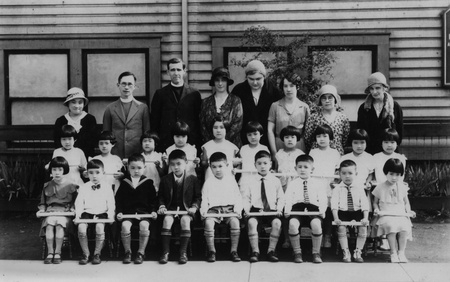
Frank and I graduated from Holy Cross Kindergarten (Anglican) as back in those days, kindergartens were not under the jurisdiction of the Department of Education but were operated by various religious groups. Both of us have a graduation picture taken in front of the building. We must have had a party as I remember being served refreshments, crackers and cheese—it was the first time I had tasted cheese. Japanese were not used to having cheese in their diet. Betty, Shirley, and Mary attended the Buddhist kindergarten, and Ken attended the United Church kindergarten during the war in Lemon Creek.
My young life was not carefree; I was afflicted with an unsightly eczema-like skin problem which made associating with others uncomfortable. At the Japanese language school, I remember loitering in the school room after class every day until everyone from the day classes had gone home and the night class students had disappeared into their classrooms; and then leaving for home wearing dark glasses (which helped a little to conceal my blemishes) when not too many students were around. I was very embarrassed with my appearance.
Our family lived a hard life, although many Japanese were in the same boat. The non-Japanese business people took advantage of the Japanese immigrants who did not master the English language, hiring them in a lower-wage bracket.
Not many young Japanese girls landed decent jobs after finishing high school, settling for domestic positions, or jobs with local Japanese merchants, working in fish canneries, etc., so there was no incentive in achieving higher education, although there were always ambitious students who persevered and did well.
I took a one year hiatus from school, but after a year’s absence, I decided to go back, so I enrolled at Grandview High School of Commerce, wishing to have a better opportunity of getting a job. Because of the delay in attending, many of my friends were in upper grades. I had to take a street car (or walk) to school which was quite a distance from home. Frank attended Vancouver Tech, getting there on his bicycle. After one year of attending high school, I could not continue (nor did other Japanese students) because of the war and subsequent evacuations.
Mom was really interested in Japanese culture and I was encouraged to learn Japanese odori from a natori, whose monthly fee was quite expensive but for which Mom paid out of her meager savings. I really hated going to these classes. Later, she encouraged my sisters and me to join a group of girls to learn Japanese odori from Miss Hayako Hatanaka who taught in her home, which we did for a few years until the evacuation. We did get to perform a few times, one at Powell Ground for the Silver Jubilee celebration of King George V of England. Hayako-san held one big recital at the Japanese Language School Hall before the war which was well received.
Many Japanese were really interested in the now famous Asahi baseball team, but since my parents were not familiar with sports, we did not join the crowd. We were not an athletic family and none of us did well in sports.
I remember when the war started, Shirley being strong-willed and guessing the financial difficulties our family faced, persuaded Betty (or rather, dragged her) to the authorities located in the Marine Building to apply for a summer job picking beans (I have no idea where she got the information that part-time farm jobs were available). They were told they were too young, to come back in a few years when they were older (Shirley, 10 and Betty, 12, at the time). Shirley seemed to be the leader, or Betty was biddable and followed Shirley’s wishes. I know that Shirley kind of looked after Betty.
A few years earlier, Mary was hospitalized because of a low blood count and needed a transfusion, being confined to St. Paul’s Hospital. One day, Dad and Betty decided to visit her at the hospital taking the streetcar. As evidence of Shirley’s strong will, she was determined to accompany them, boarded the streetcar, grabbed the bar near the conductor and would not let go. They had a most difficult time getting her off the streetcar! (Shirley’s son, Rick, now realizes where the stubbornness of his family comes from!)
In those days, many people did not have time nor money to travel out of the city, or go on vacation (what is vacation?), although many travelled back home to Japan for a visit. I remember Frank in his childhood was taken to Japan to see what the opticians in Japan could do with his not-so-perfect eyesight; it was believed back then that Japan had the best medical personnel.
Years earlier I recall Mom travelling to Steveston on one of those intercity street cars accompanying Betty to perform. Betty was considered especially talented in Japanese odori. I remember I had to console Shirley being left behind as she was younger. Betty used to perform a “duet odori”—tsuma-koidochu with Terry Nakamura (nee Yamashita, daughter of the proprietor of Yama Taxi)—which was filmed later at a studio. She also rode with Terry on a Japanese float as a bride in a parade during Vancouver’s Labour Day festivity weekend. I think Mom enjoyed these excursions away from home. She used to love doing stage makeup and dressing the girls in their Japanese kimonos. I guess it was a treat for her to get away from home for a few hours.
© 2020 Kay Mende


